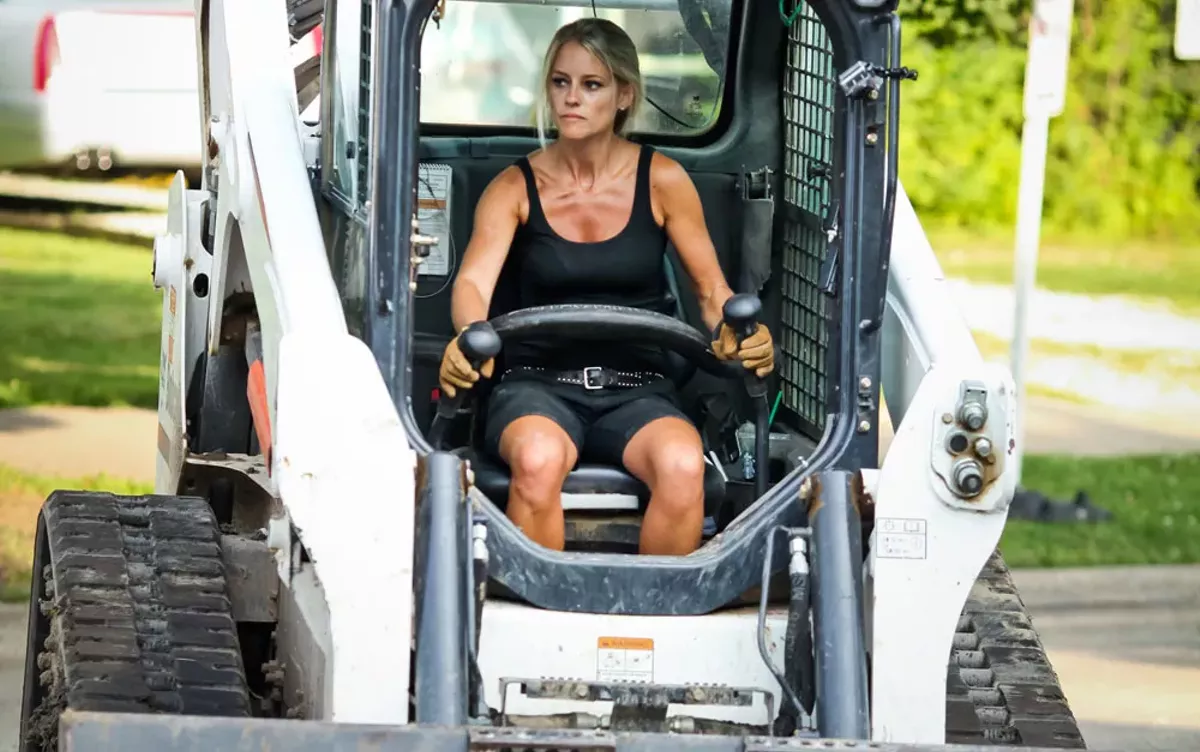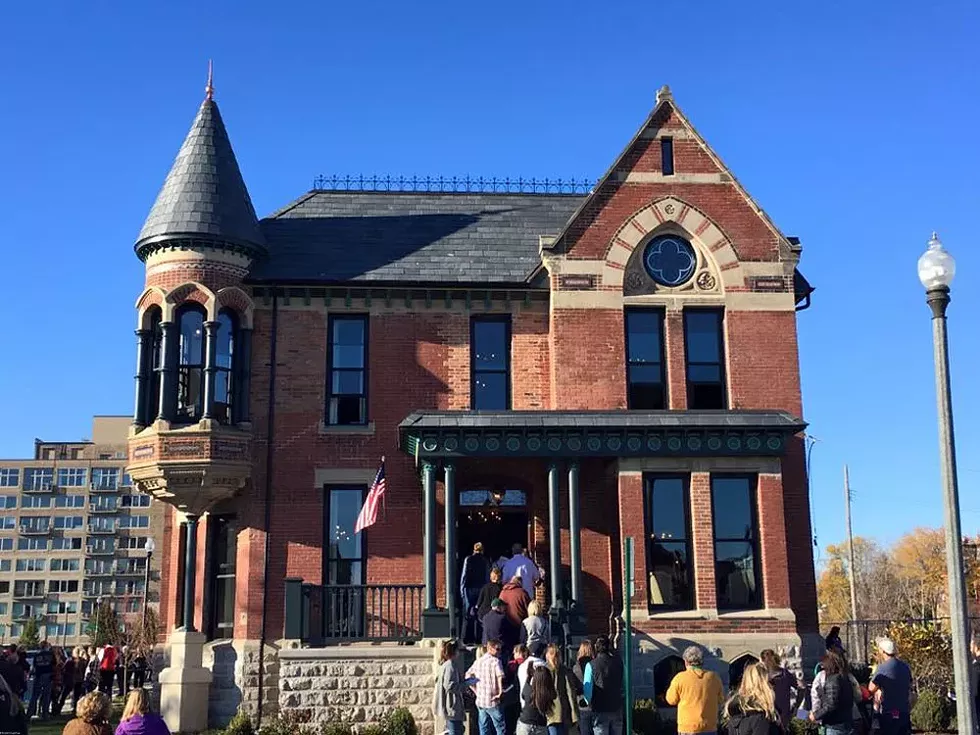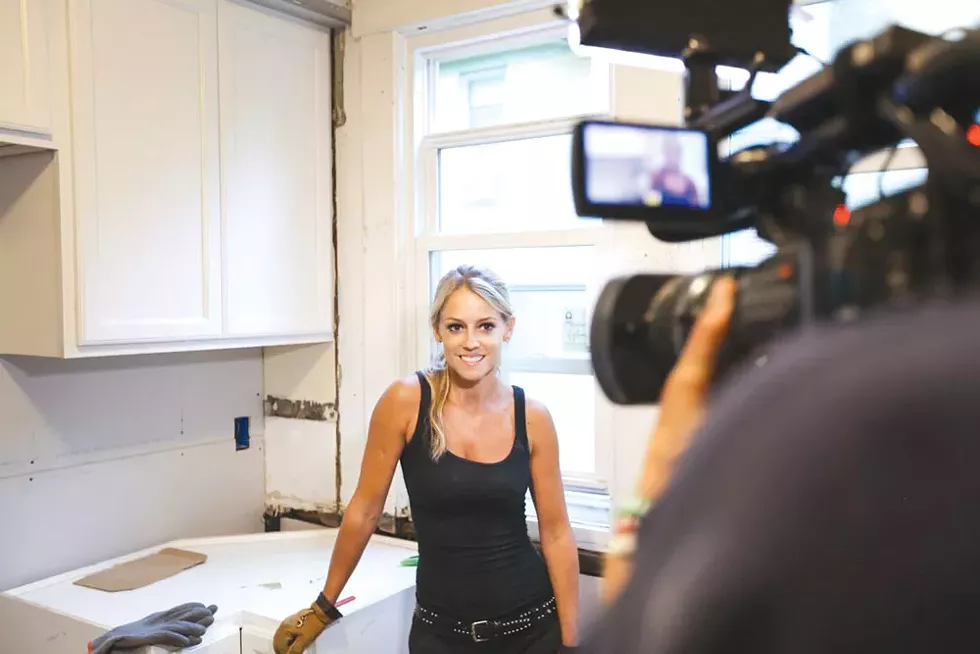As it turns out, Nicole Curtis is in person actually pretty much exactly what she's like on TV — which is to say, controlled chaos.
The reality TV star surprises us when she responds to our request for an interview by inviting us over to her home. (Her home renovation show, Rehab Addict, started its ninth season on HGTV's sister channel DIY Network last week.) But there are a couple conditions. We have to conduct the interview during her youngest son's play date with a friend. And we can't reveal her address.
As Curtis greets us, guiding us past stacks of last year's New York Times bestselling memoir, Better Than New: Lessons I've Learned from Saving Old Homes (and How They Saved Me), we express further surprise that Curtis lives in Detroit. From reading the aforementioned memoir, we knew she grew up in Lake Orion, and had recently bought and renovated her grandparents' estate in nearby Oxford. We assumed that was where a single, blonde, 41-year-old mother would choose to raise her son.
"Oh no, I hate Lake Orion," she jokes. "I just don't try to tell people where I live in the city, because they figure it out."
Curtis leads us to the upstairs of her home, done in her signature thrift store "shabby-chic" style, while her youngest and his friend do what all children their age do best — which is to say constantly come up with new creative ways of hurting themselves or destroying things.
But Curtis is calm. She never breaks her smile during our entire interview — nor does she break from our interview to breastfeed her son, lifting him up into her lap in the middle of answering a question without skipping a beat. (In fact, Curtis has become an unapologetic advocate of a mother's right to nurse in public, and has posted numerous selfies of her breastfeeding on social media.)
This is all a relative lull, she says — earlier, six kids were over. "Is that mine?" she asks when one cries from the other room. Later, when her son inexplicably produces a toy car dipped in wet paint, Curtis is utterly and impressively unfazed.
Since it premiered in 1994, HGTV's home improvement shows have become a pop culture phenomenon — thanks to hits like House Hunters, which originally aired in 1999, as well as subsequent shows like Property Brothers, Flip or Flop, and Fixer Upper. In 2016, it was the third-most popular network on cable, and this summer, parent company Scripps Networks Interactive sold to Discovery Communications for $11.9 billion.
As a rule, the network's shows are mind-numbingly repetitive, devoid of any real drama, and rife with insipid dialogue. Most star some variation of what has become HGTV's archetypal power couple — the competent and stylish interior designer woman and the charming yet doofus contractor husband, who more often than not knocks down a wall to create an open-concept floor plan. Sure, it's not the most riveting television, but it's easy to understand its hypnotic appeal. Vulture recently described it as "the HGTV formula — an endless loop of television in which the dreams of women are made manifest by the swinging sledgehammers of men."
But Rehab Addict — which first aired on DIY Network in 2010, and has also appeared on HGTV — is different. For one, there is no doofus, sledgehammer-wielding husband — Nicole Curtis can sledgehammer her own damn walls, thank you very much. And two, the show, especially its early seasons, is formulaic only in its unpredictability.
There is no doofus, sledgehammer-wielding husband — Nicole Curtis can sledgehammer her own damn walls, thank you very much.
tweet this
Within the first 30 seconds of the first episode, Curtis is 60 days from bankruptcy, her carpenter is quitting, she gets her fingers jammed in a shower door, an inspector (who proclaims, "Wow, this is illegal") is threatening to shut her project down, and Curtis tries to charm said inspector by playing dumb. Far from a sense of manufactured fantasy, binge-watching Rehab Addict gives one instead the sense that everything could fall apart at any minute.
In a voice-over, Curtis explains her premise: "I'm not your average flipper." As opposed to HGTV's fetish for those modern, open-plan kitchens, Curtis believes in restoring old houses to their former glory. "Oh my gyaaaaaad," she says in her Midwestern accent during the season one title sequence while ripping up paneling, exposing an original wooden banister. "Why in the hell would you cover that up?" Cue a montage of lithe Curtis — her midriff peeking out from under her top as she tears apart houses to reveal their inner beauty, sledgehammering walls and ripping up shag carpet — all set to a rockabilly soundtrack.
Rehab Addict is less glamorous, and therefore less fake-seeming, than its counterparts, and Curtis seems to revel in discovering and embracing her various projects' quirks. "Honestly if this was just my house, I wouldn't recoat it because I love the characteristics," she says in one early episode. "All the character shows with all the little dents. Everything wrong with the sink is what I love about it."
In another episode, while finicking about some detail, Curtis says, "Any sane person would just paint this and call it a day. No one's ever accused me of being sane, which makes my houses a little different from the average."
Reading Better Than New, it appears Curtis has always been drawn to the path of most resistance. The book paints the picture of a simultaneous rebel and overachiever; a tomboy daughter of a family who owned a garbage hauling company, a student council president who was also impeached. ("Don't ask," is all she offers on that backstory.)
"My parents' generation was taught that you stayed in a good job, raised your kids, retired, and collected your pension," she writes. "The closer I got to graduating high school, the more I knew I had to follow a different path. Telling me no just meant I would be all the more determined."
For Curtis, that meant moving across the country with her boyfriend after graduating at age 17 — first to Atlanta, and soon after, Tampa. Shortly after turning 18, she got a job at Hooters, and thanks to a driver's license typo was able to get a job bartending.
Tampa was eye-opening — "money on parade," as Curtis writes — a world away from her upbringing in Lake Orion. "My family had always budgeted tightly and scrimped and saved," she says in the book. "We were far from poor, but now I got to see how millionaires and multimillionaires lived. I thought, There's real money to be made in this world. This is the side of the fence I wanted to be on. It wasn't that I was fixated on money. I just did not want to struggle like my parents had. They had been hurt badly by the downsizing of the automotive industry. I wanted to avoid putting myself in a position like that."
It sparked an entrepreneurial spirit in Curtis. She began taking double shifts, mastering the art of the upsell. (She says she still keeps her Hooters name tag as a memento of her humble beginnings.) Soon she started a housecleaning side hustle, which is when she says she started to learn about interior design.
It's also when she and her boyfriend got the idea to try their hands at house flipping, after watching an infomercial for Carleton Sheets' No Down Payment 12 Cassette Audio Home-Study Course. Their first property was a $58,000 900-square-foot, three-bedroom, one-bath 1950s Tampa shack "that shook when you slammed the front door," Curtis writes. And long before HGTV made it in vogue, they sledgehammered a wall, transforming the carport slab into a dining room.
But Curtis was in over her head, and admits her first effort in home improvement was gaudy, and in hindsight, not a particularly sound business decision. She eventually realized she was in over her head in her relationship, too, and after a breakup she returned to Michigan — but not before buying her ex out, and keeping the Tampa house for a time as a long-distance landlord.
Back in Michigan, Curtis got a gig bartending at Bloomfield Hills' upscale Fox and Hounds. She also got back with her ex, and at 20, became pregnant. She enrolled in community college, continued her housecleaning side-hustle, and eventually sold the Tampa house, which enabled her to buy her second fixer-upper — a 1928 bungalow in then up-and-coming Ferndale. She also says that's when she started her interior design services, offering free design advice provided she could photograph it and put it in her portfolio.
After her oldest son, Ethan, was born, Curtis started dating someone new, which led her to relocate to Minneapolis. She got her real estate license, and around 2008, starting buying houses in Minneapolis' "on fire" housing market.
One day, while checking her voicemails, she found a 2-week-old message from a company called Magnetic Productions looking for real estate experts to appear on camera for DIY Network's Sweat Equity. Apparently, a production assistant just stumbled across her photo on her website and figured she looked photogenic enough to be on TV. Surprisingly, they were still looking when she called back, and invited her in for an audition.
But on the way to the audition, Curtis says she got a different idea — she instead decided she would pitch a TV show of her own, and made up her spiel about saving old houses. It worked. The producer was impressed with the idea of tiny, feminine Curtis doing her own plumbing and drywall, and Rehab Addict was born.
Curtis turned out to be a natural on TV, although it was the first time Magnetic Productions had done a show like it. As should be well understood at this point, reality TV is not really reality. Even a straightforward "docu-reality" show like Rehab Addict has a producer to guide the story along. But for the first season, Curtis says she and the producers had no clue what they were doing and just filmed everything, not sure what they would use.
The show was an instant hit, and HGTV ordered another season. And another. And another. But behind the scenes, Curtis' life became even more dramatic.
For the past two years, Curtis has been in and out of court. This year, the city of Minneapolis filed suit, alleging she breached contract by not completing construction by the city's deadline for a dilapidated property originally slated for demolition that she purchased for $2. (A contractor quit, and by the time Curtis lined up another, she says, the permit expired.)
But it was also during that time that Curtis was in an on-again-off-again relationship with a Minneapolis businessman named Shane Maguire, and became pregnant with her youngest son — a fact she kept secret from her show by hiding her belly and shooting from the shoulders up. (Some eagle-eyed fans saw through the ruse and outed her on Facebook.)
Also in 2015, Maguire filed for joint custody. A bitter custody battle ensued. According to The Detroit News, Curtis attempted to block overnight custody and charged that Maguire endangered her son by bringing him to a Black Lives Matter protest; Maguire's lawyer requested that Curtis be psychologically evaluated. Curtis' own mother requested a personal protection order against her daughter for "mental fits of rage," threatening phone calls and emails, and for driving "recklessly" in a court parking lot. A judge denied both requests, but threatened Curtis with jail time for contempt of the court.
"I'm deeply embarrassed about our family," Curtis told the judge.
With the city of Minneapolis at her back, and a new baby, returning to Michigan seemed to be the obvious move.
"I always think, my life is really fucked up at times, but I always find some path to lead me to, 'We're going to get out of this, we're going to go this way.' And with that, Detroit — why not?" Curtis says. "I really wanted to go home and shoot. It was important to me. My business and my life has taken a really bad toll on my family, and it was just insane."
But there was another factor that drew her home. Since she left, Detroit's story had changed, and it enjoyed a new narrative as a comeback city.
"Everyone who could get out of Detroit in 2006 and 2007 left," she says. "There wasn't any money to be made in design. I tapped out cleaning houses. I used to clean houses for GM executives and Ford executives — nobody had a job anymore. So all of a sudden you're a $150 a week expense, and you're the first thing gone."
Initially, Curtis says she was drawn to Detroit by when she heard there were old firehouses for sale. She arranged a meeting with James Marusich of the city's Planning and Development Department. The firehouse plan turned out to be a wash — they were in too poor of shape, Curtis writes, and anyway they didn't have the fire poles.
But while driving around the city Marusich took Curtis to Brush Park, where he gave her a tour of the grand yet dilapidated Ransom Gillis House, a historic 1876 mansion known for its castle-like turret and for being the original home of Pewabic Pottery. Meanwhile, a fan called to tell her about an abandoned, fire-damaged house on Campbell Street in Southwest Detroit. She went back to HGTV and sold them a Detroit storyline.
In the book, Curtis describes Detroit as the "Wild West." "The people up and down the street had seen a city government not only give up on the local community, but also actively rob them of their tax dollars," she writes. "They didn't trust outsiders. You can go into an area like that trying to be a missionary or a martyr, or you can go in there and be like a neighbor."
She says she befriended some neighborhood kids by asking if she could drive their go-kart. The kids later offered to help her with painting. She says she taught one of the kids how to mow the lawn, and he wound up making a summer job out of it.
However, the Detroit projects weren't without problems. The city issued a stop-work order on the Campbell Street house when Curtis failed to pull proper permits, according to the Detroit Free Press. Last winter, the house's sewer pipe burst and it remains unoccupied, but Curtis says she regularly maintains it. In 2015, Curtis took to Facebook to rant that she had been the victim of an attempted carjacking, in which a robber reached into her car while she was loading her son in and made off with a laptop.
And then there was the Ransom Gillis project.
When she returned to Detroit, Curtis' plan to rehab the mansion hit a snag: The house was sold as part of a large swath of properties to billionaire Dan Gilbert's Bedrock Development as part of a $70-million redevelopment project. A compromise was reached: The show would be a sort of standalone series, an eight-episode arc called Rehab Addict: Detroit.
When asked about the name change, Curtis shrugs in bewilderment. "We already shoot in Detroit. It already is Rehab Addict: Detroit," Curtis says. "I have no answers to that. It's all just Rehab Addict."
However, there's a perhaps obvious reason for the name change: Rehab Addict: Detroit was sponsored by Gilbert's mortgage-lending conglomerate Quicken Loans, who exerted creative control over the construction and the shooting. Throughout the season, former Quicken Loans president Jay Farner even makes various appearances, offering a series of increasingly hyperbolic declarations about the meaning and magnitude of the project:
"To see this coming back represents more than a house coming back. It represents the city coming back."
"This is a great symbol of everything that's happening here in Detroit."
"This is inspiring a bunch of folks to either move to Detroit, renovate their homes in Detroit. This is a lot bigger than one house."
But Rehab Addict: Detroit is also markedly different from the show's other seasons in that, on-camera at least, the project appears to be nearly 100 percent drama-free. Anything that could be rounded up to drama was seemingly manufactured by Curtis — her insistence on redoing a bannister to a staircase, moving a toilet, expanding the size of a shower. At one point, she has a visceral reaction to the suggestion of chopping up an intact, historic mantle to make it fit — she would rather leave it original.
However, there was actually lots of drama behind the Ransom Gillis project. As Curtis writes in Better Than New, "the lunacy started almost immediately."
In the book, Curtis says she was horrified to learn that Quicken Loans wanted to rehab the mansion as a four-unit condo. Rehab Addict's whole premise is restoring homes to their former glory, and Curtis wanted to make it a single-family home as it was originally intended. The two parties argued back and forth until eventually Quicken Loans settled on a duplex. Curtis relented, figuring it would be easier to just go with the flow and let Quicken Loans do the heavy lifting.
"You know, they're like, 'Ahh, Nicole's a pain in the ass,' or whatever. But there's certain things where I'm like, 'You know, if we're spending this kind of money, let's do it right,'" she says. "If there's any house in Brush Park that should be as close to original as possible, it should be that house — especially with the money that was being thrown at it."
Curtis says she can understand Quicken Loans' insistence on a four-unit, which would cater to their ideal employee demographic — the moneyed millennials who want to live in the city, filling the city's numerous new luxury apartment complexes. However, she doesn't think that's the kind of housing developers should prioritize.
"I get all that. But here's the thing that I keep saying over and over again," she says. "That's all great in theory, but you have to have something that's sustainable. You have to have an owner occupancy in the city. And when you have 25-year-olds who are renting a studio loft ... as soon as they get married and they have kids, they're in the suburbs. And unless you have this constant flow of new talent coming in — and this is scary because this is what happened to Detroit in the past, and it's what happened in other major cities — you can't sustain that."
‘I still think it’s really important that we stress that all neighborhoods are important — not just Midtown, and Woodbridge, and Corktown.’
tweet this
Curtis is critical of much of the recent renewed development in Detroit — particularly its focus on the trendiest neighborhoods. "I still think it's really important that we stress that all neighborhoods are important — not just Midtown, and Woodbridge, and Corktown," she says. "Because really where we have the most lifers is like these little pocket neighborhoods, not the trendy places."
And that's where Curtis sees herself as set apart from Detroit's redevelopment.
"It's kind of hard right now because there's so many hands in the pot. There's an inconsistency of what houses are getting saved and which aren't," she says. "I don't like the investors that are coming in, and they're flipping these houses in Detroit. And all of a sudden I'm seeing granite and like, open-concept kitchens in these tudors that have stood pristine for years that nobody wanted. That's rubbing me the wrong way."
These days, Curtis says she splits her time between Detroit, Minneapolis, and Florida, to be with her grandfather. She lives with her youngest — Ethan, once a constant figure on the show, now spends his time away from the camera in Minneapolis.
Curtis says she loves Detroit. She says she shops at Eastern Market every week, and regularly rides her bike as part of the Slow Roll. She says she's an avid runner, and enjoys exploring the city on foot.
She says she believes in being a part of the community, even if she's only a part-time resident. "You have to get involved at a city level. Whoever, our president is, it doesn't really matter. We need to see more people running for board of education, for city council, things like that," she says. "Because on this local level is what makes a difference in all of our lives."
The new season of Rehab Addict takes place in metro Detroit — she says they didn't want to film in Minneapolis after the drama with the city. It starts with two houses, both originally built in 1928; one in Ferndale, and one in Birmingham. (Earlier this year, the Birmingham house got hit by a speeding car during a police chase.) Neither are particularly glamorous or intriguing, but Curtis is convinced the Birmingham house would've been demolished if she didn't buy it.
She says she returned to the show somewhat reluctantly — between caring for her youngest and her recently widowed grandfather, Curtis says she has a full plate. But eventually, she couldn't resist.
"I was like, you know what, this is stupid. I need to get all this while I can," she says. "We like doing the show, it's just I did so much at once. We didn't stop working for seven years. It was insane. I worked the whole time I was pregnant ... we shot 19 episodes in three months after I had the baby. And then I had a book. My grandmother passed away. It was just too much at once. So we took a break because I wanted to get in a frame of mind where it's fun again to be building. And now it is fun."
Curtis says she has more flexibility now. While filming, her lead carpenter’s daughter was going through chemotherapy, so Curtis says they needed to both be able to schedule around their families.
"Our families dictate," she says. "If we were really a gung-ho construction company and I really had my head in the game, we could be turning out hundreds of houses. But we just can't. So the ones we pick, we're very selective."
Curtis says these days, her role is more of a producer — she doesn't do as much actual building anymore. "It doesn't mean that I still can't frame a wall, or take a wall down — trust me, I can, but I don't have to," she says. "I think when I was 25, 26, 27, I needed to prove to everyone that I could."
She says she's more interested in trying to find new ways to make her projects more sustainable — not in terms of eco-friendliness per se, but to make them last longer. She also says her new baby has got her to start thinking about how to make her projects more child-friendly.
Looking back, Curtis admits this is not the life she dreamed for herself. "I never know where my life is going to be because it's been so odd. I was cleaning houses. I had my little cleaning business out of my house in Ferndale. And honestly, I keep joking when stuff gets so stressful, I'll go clean your house," she says.
Until then, Curtis remains a somewhat unlikely TV star. "I'm not very PC, obviously. If I was, I probably would be a lot further in TV-land. But they never know what's going to come out of my mouth. I mean, I never know what's going to come out of my mouth," she says. "For me, it was just about providing security for my family."
And that's why, she says, people continue to tune in. "My viewers aren't standard viewers. The standard HGTV viewer is like, 'We're getting engaged! We're married! We're having a wedding shower! We bought our first house!' I still have those people, but it's just a different kind of vibe," she says. "They know that my life mirrors their life. I have problems. They have problems."
She adds, "I always laugh. It's like, one day, people... if I'm like, 'happily ever after,' the show's over. There's nothing to film. Nobody wants to watch that."
The new season of Rehab Addict airs Wednesdays at 9 p.m. on DIY Network.










